This Seax is crafted with a damascus bladed with particularly vibrant patterning; no mere surface etching, these patterns were created when two differing steels were pounded and melded together into a single billet from which the smith would forge the blade. The folding and layering of the steel creates these rippled, water-like patterns within the steel which were brought into bold visibility with careful surface treatment after forging and shaping the blade. Like a fingerprint, every blade crafted this way differs slightly in its unique patterning.
The grip is formed from a carved cut of dark hardwood. The guard is a slab of cross-hatched horn pinned between two steel guard-plates. The pommel cap is likewise crafted from steel. The companion sheath is of stitched leather with both horizontal and vertical hanging loops paired with a grip-retention strap with a brass button.
Though many seax were quite simple and humble in design, those that could be afforded by men of means often had blades of pattern-welded steel. This steel was created when the smith formed bars of differing steel which he artfully twisted together to pound and form into a single blade. The steel was deliberately twisted together in a specific manner which would create repeating patterns on the blade. Not only did this make a beautiful finished product, but the merging of steels of differing hardnesses typically created an overall better blade in an era that predated the industrial availability of substantial amounts of quality iron ore and the means to refine it in large quantities.
Much of the skillful steelworking by the bladesmith in the dark ages Northern Europe were innovations intended to optimize the quality of the smelted bog iron, which would be of poor quality without skillful refinement and clever smithing techniques to refine and combine the varying quality of this iron. In this way their work shares a similarity with the bladesmiths of Japan, whose many skillful innovations were created to overcome the initially poor and irregular quality of iron smelted from iron sands.
This Seax blade is damascus, which though different in process from pattern-welding, does share the similarity in that steels of differing hardness are skillfully and artfully worked together into a single billet. Like pattern welding it creates beautiful patterns in the steel which are a testament to the skill of the smith and a homage to some of the iconic blade-making techniques of older centuries.
The smiths of old could only dream of the access that modern smiths have to high quality, pure steel. But the modern convenience of such steel brings quality without the unique processes of folding and layering steel that were essential to create worthy swords from comparatively poor quality iron ore in elder years. A by-product of these techniques created uniquely visible qualities to a blade and the best of smiths knew how to harness this to create excellent weapons imbued with the beauty that comes from skillful mastery of their craft. Each one of these weapons was unique and understood to possess a unique spirit ensorcelled within at its birth in heated forge-fire, earthy anvil and rhythmic hammer.


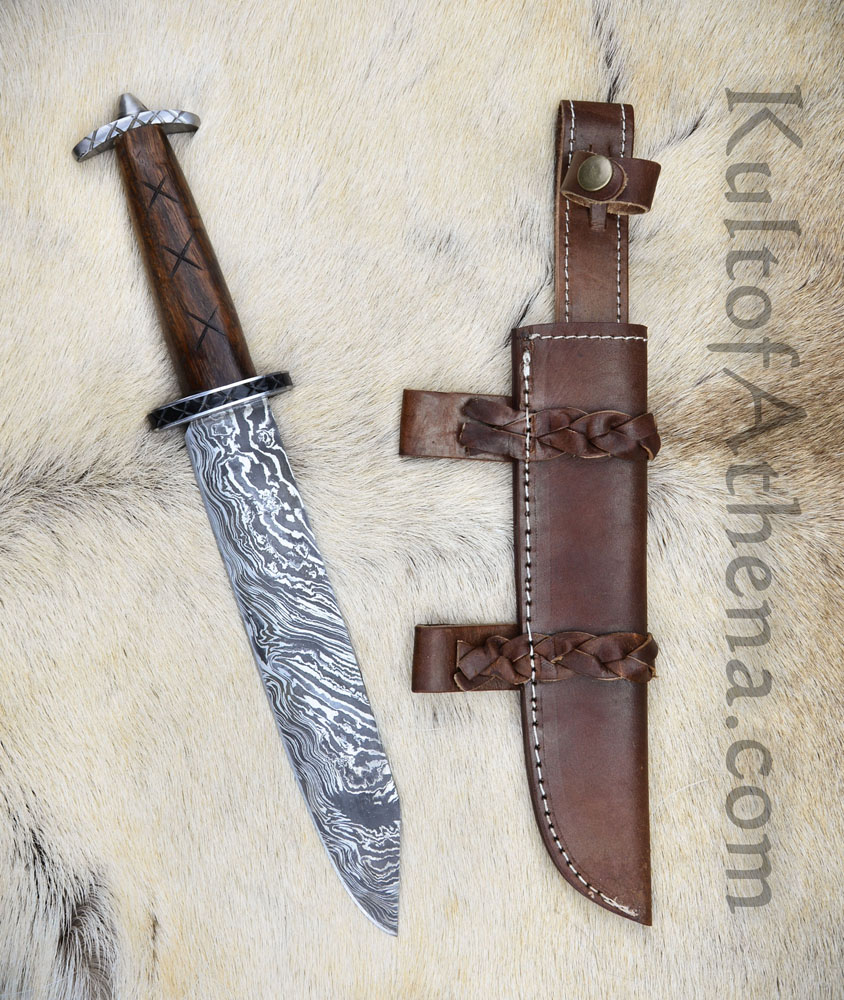
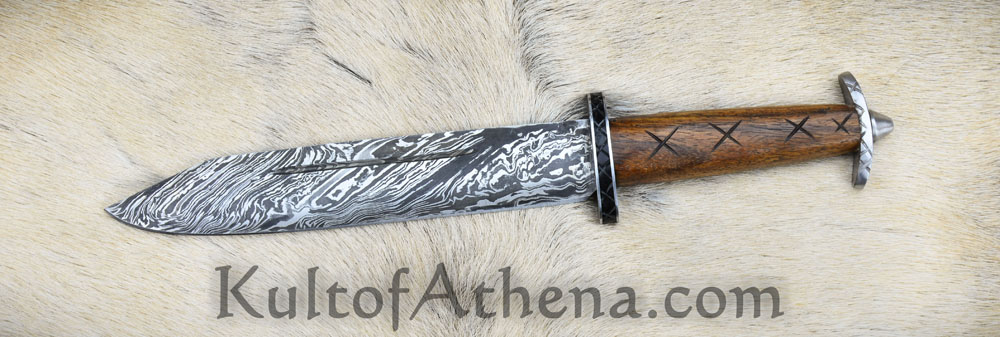
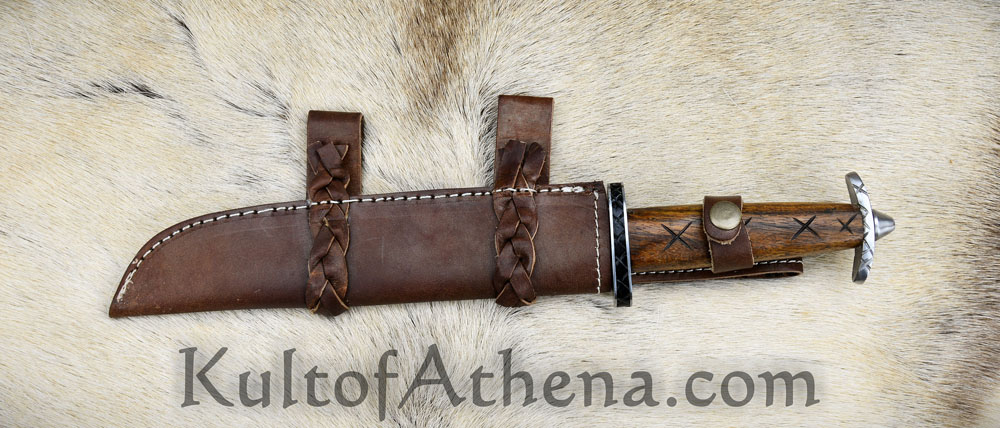
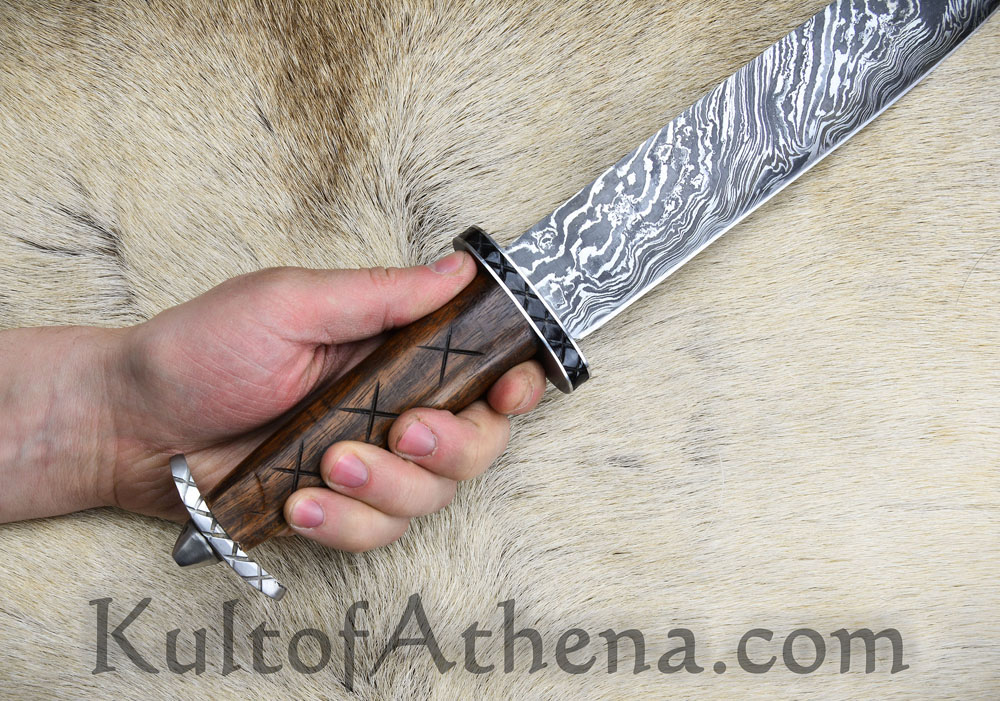
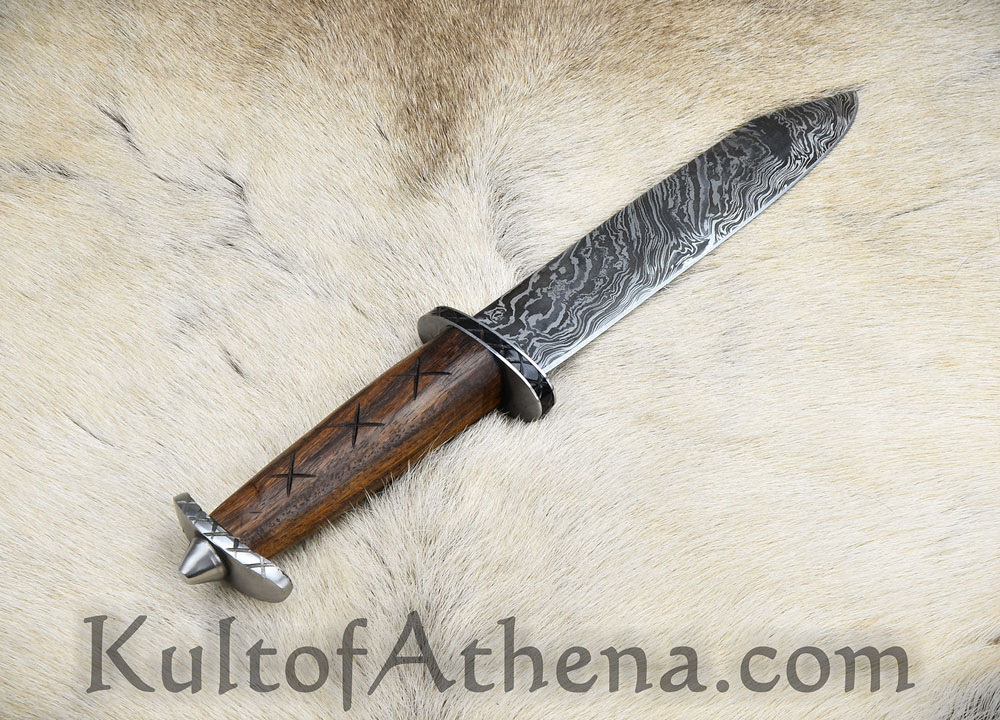
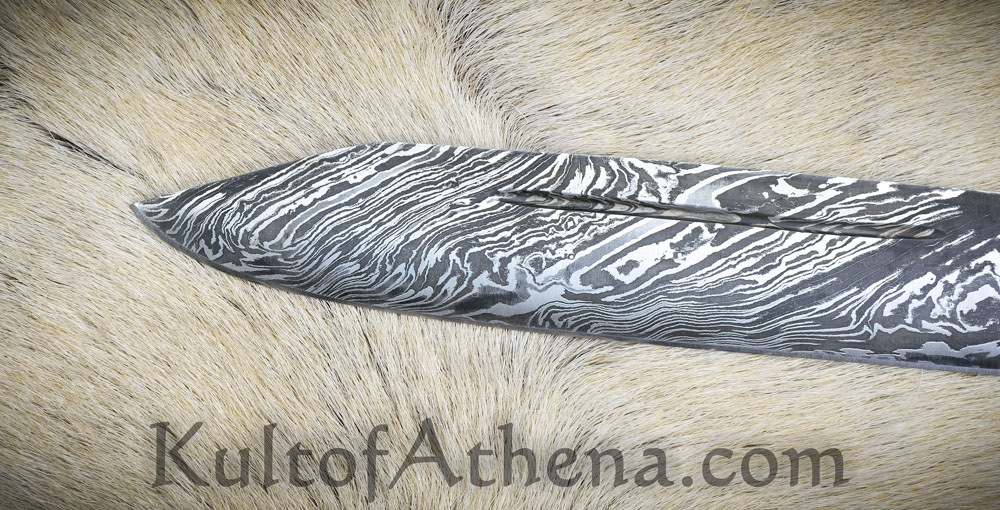
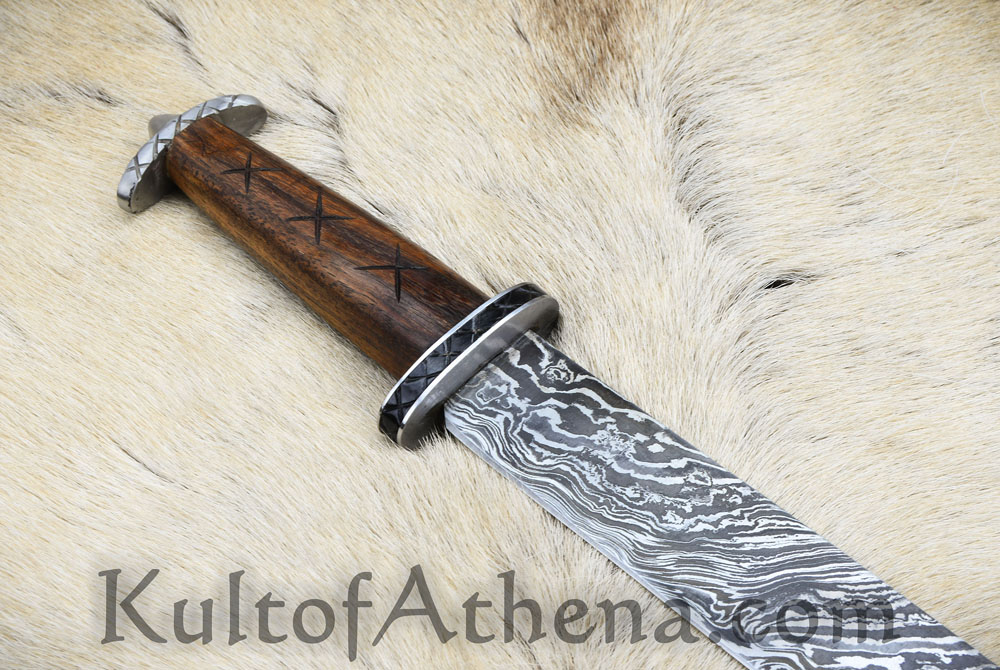
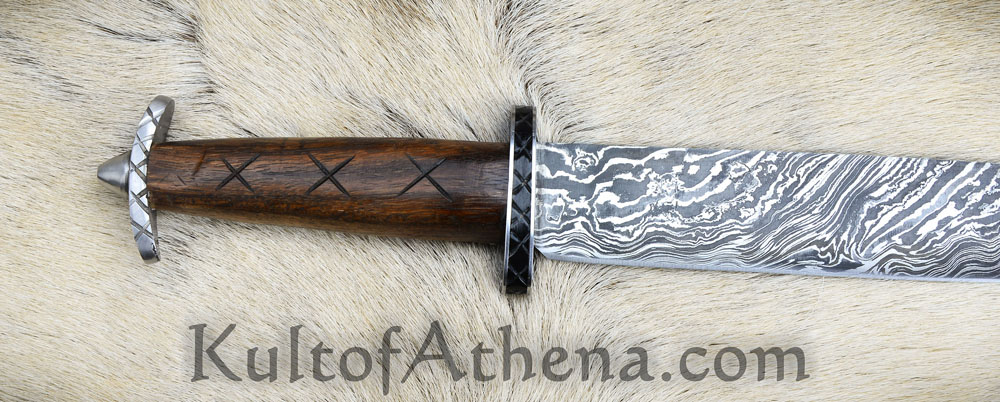
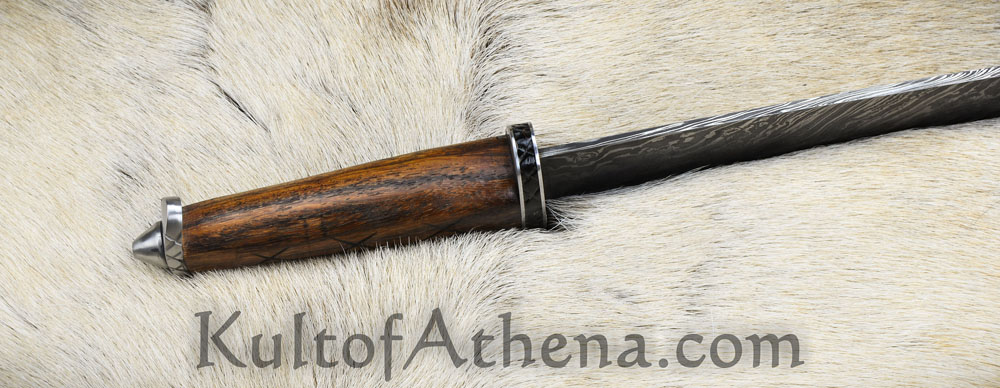
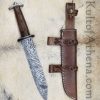
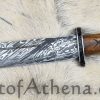
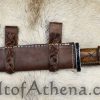
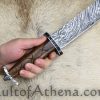
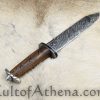
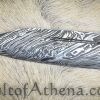
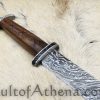
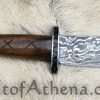
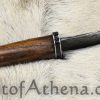
Z –
Pretty solid seax/dagger This particular seax is a bit lighter than its size would suggest (to me at least). What weight you do feel is toward the blade which seems appropriate. The pommel if you would call it that is glued on and the piece that sticks out seems pretty solid. The blade comes sharpened although it doesn’t cut through paper that well, more of a tearing than cutting or slicing. Where this piece shines is in the thrust and its a pretty good chopper. The leather sheath is pretty good quality however the piece of leather with a snap button near the handle of the seax shifts. So far I’ve tested this on small water bottles which it leaves a nasty gash through and smaller tree branches for chopping and its pretty fun to use. At its price, I can’t really complain about it so far.
Arran –
love the blade but some minor issues purchased for 74.95 bit more then id normally pay for a dagger but i liked how it looked arrived quickly only 7 days and was visually pleasing and could cut paper straight out of the box with ease this is slight problematic as there was a issue with how they chose to pack such a sharp blade they wrapped the sheath and blade separably so when i went to unwrap the blade it almost cut my finger not expecting to be griping a bare blade don’t know why this was done but poor choice in my opinion the blade its self stood up to a water bottle cutting test relatively well it made some cuts in the bottle but didn’t slice clean though as i had hopped it would but stabbing the bottle it went through like butter only sad thing is the edge rolled slightly in some areas during cutting the water bottles just minorly nothing that would rely affect the blades performance to much so all in all i give it a 3 1/2 -1 for unsafe packaging -1/2 for the edge rolling against only a plactic water bottle still pleased with my purchase tho
Ein –
Excellent Blade Cuts through paper with no problems whatsoever. A great addition to any collection and it arrived in only 3 days. Only real gripe is some of the adhesive that holds the handle in place with the guard was peeling right out of the box, and the steel on the pommel had some slight imperfections (personally, I think it just adds to the character), but it’s nothing that will cause any issues.
Jeff –
A Beautiful Working Blade Everything about this blade is amazing, not only is the work quality but the blade holds amazing edge. I first bought it as a show piece now it accompany’s me ever hunt I take. FYI when they say it long, its an understatement an inch or two longer and it would truly be a short sword lol however the craftsmanship and style can not be beat.
Erik B. –
Great knife for use and display! This was my first seax, and it is absolutely beautiful. It looks great, and it is incredibly sharp right out of the box! It’s incredibly light and feels great in the hand. It is a really nice chopper and slices with ease. The damascus steel is beautiful, and I currently have this on display on my wall! It always draws the eye of my visitors! A great, fun blade!
Nancy –
Beautiful blade! Great addition to my Dark Ages weapon collection. Edge came very sharp, cuts sheets of paper like butter. Very pleased with this seax.
James –
A bit disappointed. I received this as a gift. I ONLY use/buy battle grade weaponry. The guard was loose and rattling. The blade was sharp enough to cut but not as sharp as you’d expect from an “out of the box” blade. Aesthetically it is pleasing but I don’t know if I’m willing to rely on it.